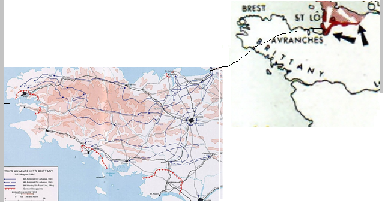

 August 1, 1944. Under General Omar Bradley's 12th Army Group, General George S. Patton's command of the US Third Army was official. Patton had been in nominal command of the Third Army since the beginning of the snake-fanged Operation Cobra. Now, through the battle-opened Avranches Gap, stalled in Normandy US soldiers would advance on enemy positions in Nazi-occupied Brittany.
Bolted to its front, every fifth tank in Patton's Third Army now had a hedgecutter made from the German steel that littered the beaches of Normandy. "So much for the damn dense tree and shrub barriors, from behind which hell-born Nazi soldiers lurked," Patton thought as he watched a demonstration in which one of his Sherman tanks demolished an entire hedgerow mound.
August 1, 1944. Under General Omar Bradley's 12th Army Group, General George S. Patton's command of the US Third Army was official. Patton had been in nominal command of the Third Army since the beginning of the snake-fanged Operation Cobra. Now, through the battle-opened Avranches Gap, stalled in Normandy US soldiers would advance on enemy positions in Nazi-occupied Brittany.
Bolted to its front, every fifth tank in Patton's Third Army now had a hedgecutter made from the German steel that littered the beaches of Normandy. "So much for the damn dense tree and shrub barriors, from behind which hell-born Nazi soldiers lurked," Patton thought as he watched a demonstration in which one of his Sherman tanks demolished an entire hedgerow mound.
A few days ago, the Avranches gap was opened by four of the 12 divisions now under his command. Also under his command was the XIX Tactical Air Command, led by Brigadier General Otto P. Weyand, in Patton's opinion "the best damn general in the Air Corps". Forming a fighter plane umbrella, the XIX TAC's P-51 Mustangs would cover his troops from above.
A constant stream of intelligence would flow from G2, under the command of Colonel Oscar W. Koch, who served as the Third Army's mobile headquarters chief of Army intelligence. And, a British Intelligence Special Liaison Unit, headed by British Major Melvin Helfers, would -- from Bletchley Park -- relay ULTRA intelligence on the movement of the German Army.
At Patton's camouflaged headquarters, among the on foot scouts placed with every division of the Third Army, was a just recuperated from Battle of Normandy injury, California-born officer, who had trained with Patton at Camp Iron Mountain in the Mojave desert and was sent by Patton himself to the British Army Commando Training Center in the Scottish Highlands. First Lieutenant Ted Treharne.

